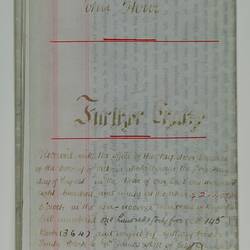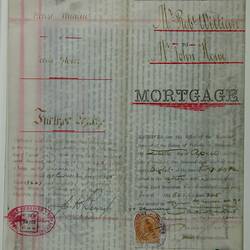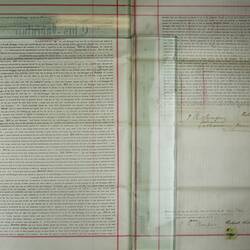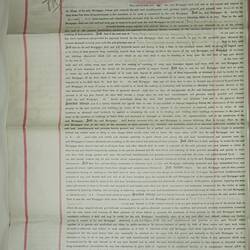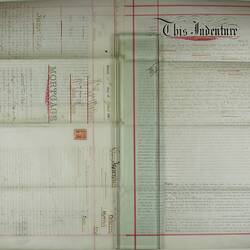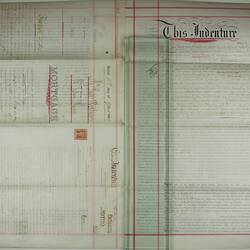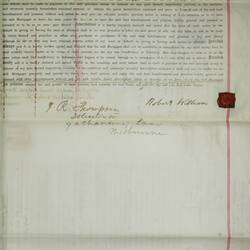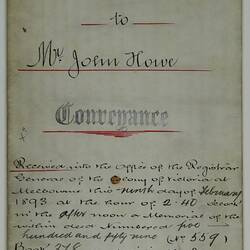Summary
Handwritten and printed mortgage dated April 20, 1888. Robert Willian mortgaged the Princes Street property to John Howe, gentleman, of Williamstown, for £270, to be paid in monthly £8 instalments. This contract was witnessed by J.R. Thompson, solicitor, Melbourne. In an addition to this document made at the same date and time, Robert Willian borrowed a further £44 from John Howe, making a total of £314 owing. This extra amount was to be paid in monthly instalments of £4. For Robert, this meant repayments were now £12 per month.
This document sits chronologically in the middle of four such documents, representing the financial dealings of Robert Willian and others, regarding this same property over the space of eight years. Eventually being unable to make repayments, this piece of land became the property of John Howe in 1893.
Robert William was born in what is now Port Melbourne in 1862. Working as a blacksmith for the Victorian Railways from 1880 until 1922, Robert spent his early life in the Williamstown area, later moving to the Ballarat area where he died in 1927.
The document was drawn up and verified by Henry Hunter, Melbourne, clerk to Messrs Pentland, Roberts and Thomson and signed by Henry Krone, acting Registrar-General. An addition made in 1890 documents a 'Further Equity (?)' between John Howe and Robert Willian.
Physical Description
One sheet document folded three times, with title, date and names on cover. Postage stamp and textile ribbon on cover. Large amount of text printed and written in black ink with ruled red ink borders and underlining. Postage stamp and two red wax seals on inner page.
Significance
These documents, and the related personal stories, are significant to the state of Victoria and also to the areas of Williamstown and potentially Ballarat. They represent a single person's financial and personal struggles but also place this man within the larger context of the Depression of the 1890s and the many affected.
Aspects of the lives of the people mentioned in these documents (and their families) represent a community's involvement with events and themes in Australia's history that many feel define the nation, including immigration and a pioneering spirit of adventure, both world wars, the depression of the late 19th century. and the influenza pandemic of the early 20th century.
The documents also suggest a sense of community - both as part of Williamstown's Scottish community and the wider Williamstown community.The men involved in this property's history were workers, doctors, architects, carpenters; rich and poor, yet they were all part of one close and vibrant community, where 'class', in the traditional sense of the word, did not appear to limit people's interactions with one another.
More Information
-
Collecting Areas
-
Acquisition Information
Purchase
-
Person Named
Mr Robert M. Willian, Williamstown, Greater Melbourne, Victoria, Australia, 1888
-
Person Named
Mr John Howe, Williamstown, Greater Melbourne, Victoria, Australia, 1888
-
Inscriptions
Front cover title: 'Dated 11th day of April 1888, Mr. Robt. Willian to Mr. John Howe, MORTGAGE. RECEIVED into the Office of the Registrar General of the Colony of Victoria, at Melbourne, the twentieth day of April in the year of our Lord One thousand eight hundred and eighty-eight at the hour of 1.45pm o'clock in the after noon, a Memorial of the within Deed Numbered six hundred and forty five (No. 645) Book 375 and verified by Henry Hunter of no 90 Chancery Lane Melbourne, Clerk to messrs. Pentland, Roberts and Thompson of the same place. (signature of Henry Krone), Acting Registrar General'. Reverse cover title: 'Dated the fourteenth day of August 1890, Robert Willian to John Howe, Further ?? (possibly says 'Equity'). Received into the office of the Registrar General of the Colony of Victoria at Melbourne, the fourteenth day of August in the year of our Lord one thousand eight hundred and ninety at the hour of 2.40pm, o'clock in the after-noon a memorial of the within Deed numbered One hundred & forty five (No 145) Book (364) and verified by Anthony Partler (?) Smith (?), Clerk to Mr James Hall of City Chambers Elizabeth Street Melbourne, Solicitor. (signature of R Baurgh?), Deputy Registrar General'.
-
Classification
-
Category
-
Discipline
-
Type of item
-
Overall Dimensions - Folded
122 mm (Width), 328 mm (Height)
-
Overall Dimensions - Unfolded
477 mm (Width), 655 mm (Height)
-
Keywords
Property Development, Legal Documents, Real Estate, Architecture, Architects, Wills, Railway Workers, Melbourne & Hobson's Bay Railway, Railway Rollingstock, Railway Workshops, Blacksmiths, Carpenters


